Serves 6
Level of difficulty 2.75

Procedure:
Preheat a sous vide bath to
140 F/60 C
Vacuum and seal the brisket in a heat rated bag. Sous vide process for
48 hours
After the interval has elapsed, shock the package in iced water until it achieves 70 F/21 C–about 15 minutes. Refrigerate to 40 F/4 C before proceeding.
Before we make the soffrito
Remove the large stems from the parsley. Pulse in the food processor until finely chopped.
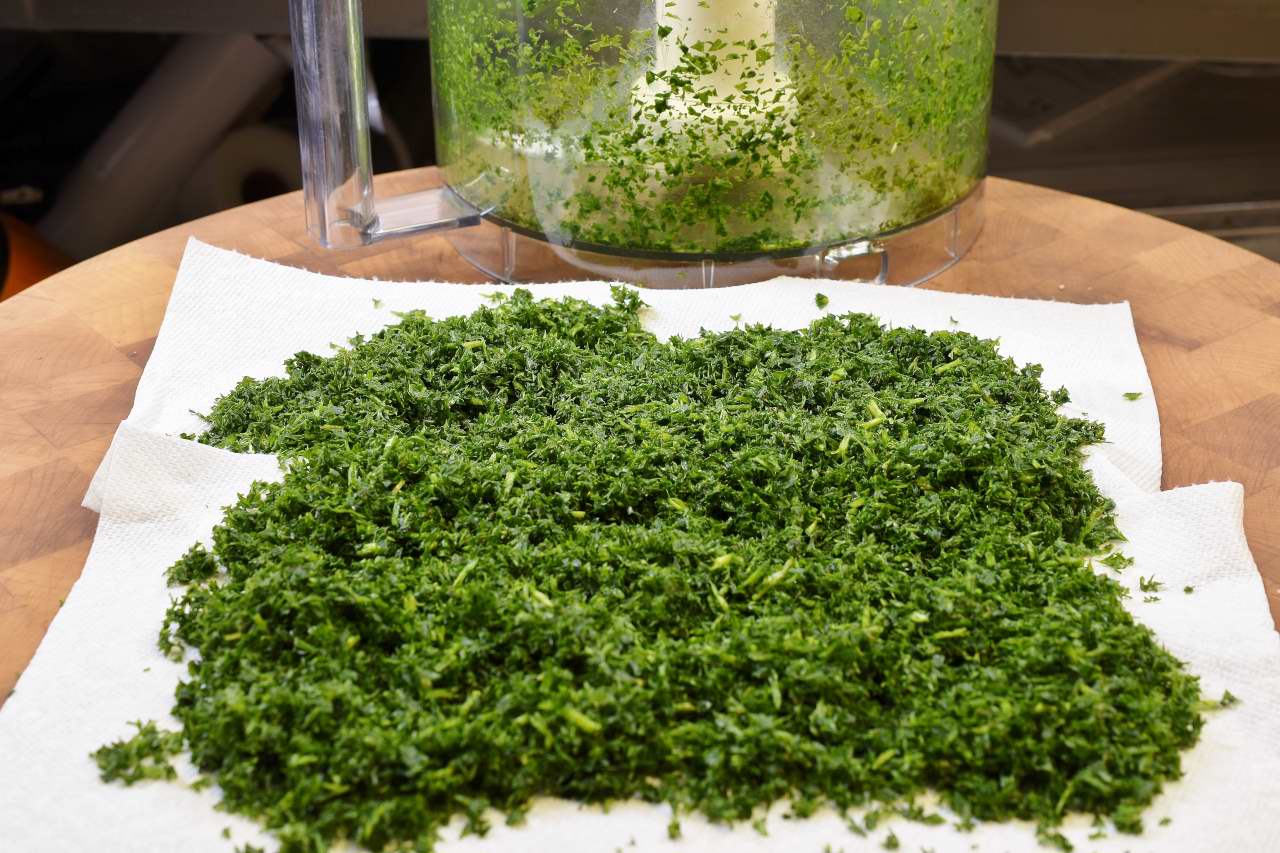
Parsley has a tendency to develop a moist appearance. At this point, many people decide that it’s just not worth the trouble and substitute dried.

Rather than do that, wrap the parsley in paper towels. People buy vacuum devices for sous vide and then promptly forget that they are not just for sealing meat in a bag.
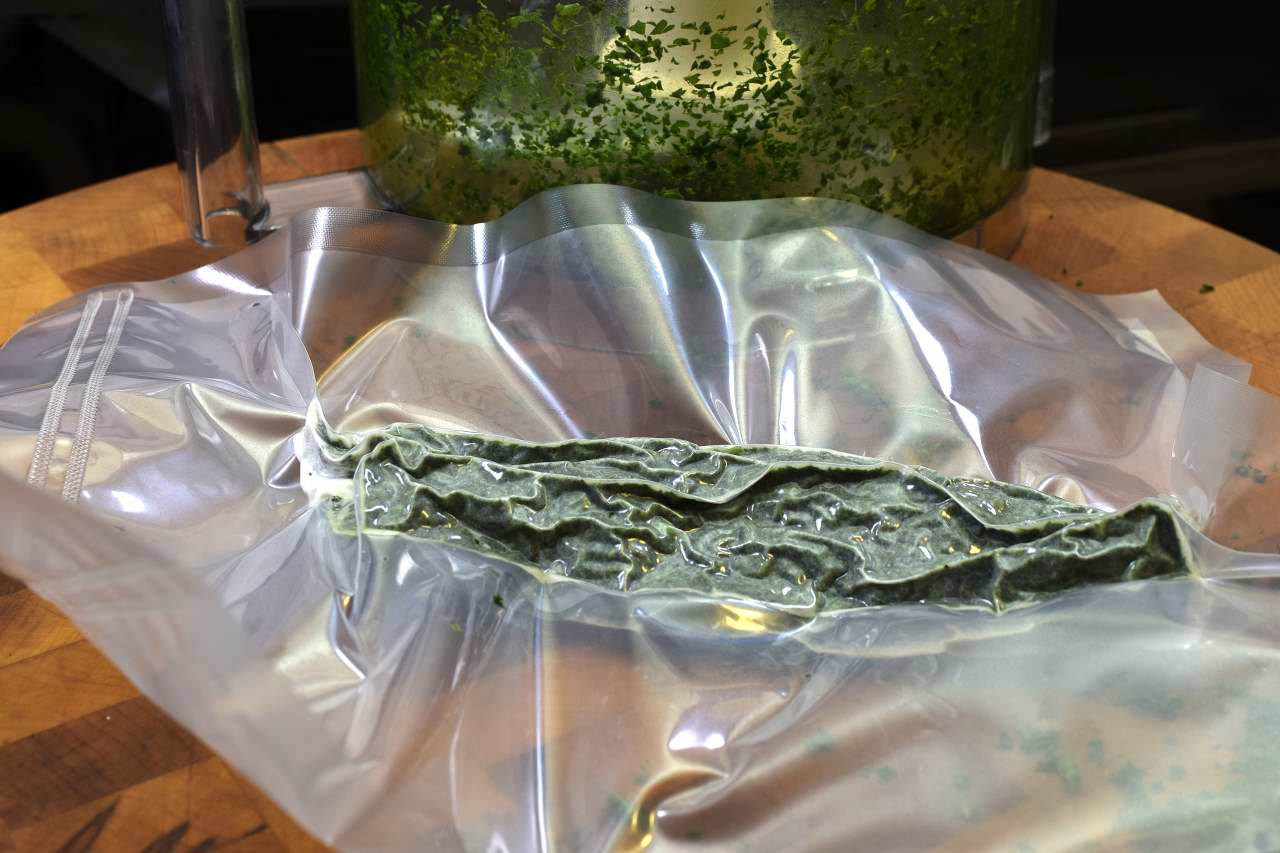
Vacuum the parsley. Set aside. Do not wash the food processor yet. Peel the carrots and onion. Along with the celery, cut them coarsely into 2’/60 mm pieces.

Pulse the vegetables in the food processor until they are finely chopped. Set aside.
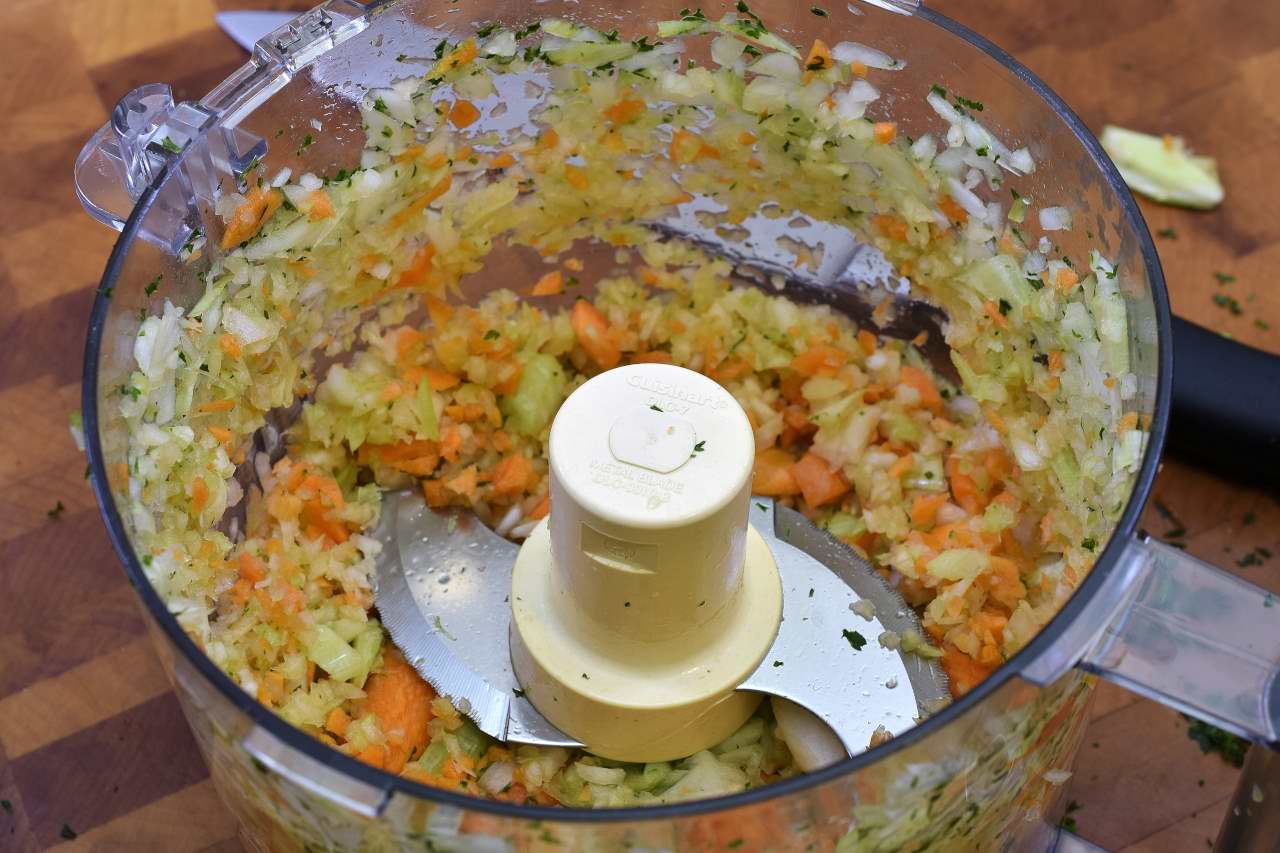
Now you can stage the hopper and blade to the dishwasher’s station. Make sure you smile at the dishwasher when you drop off.
Now if I had a hammer
Smash the garlic with the flat side of a knife or mallet. Remove and discard the peel. Sprinkle the smashed garlic with 1 teaspoon of salt and wait five minutes. Return to the garlic and you will see that it has released some moisture. This will help hold the garlic still while you smear it with the flat side of the knife and finish chopping it. Set aside.
Submerge the package of brisket in hot tap water (or a running sous vide bath) for two minutes to dissolve the gel.

Set the colander on top of the sauce pot and line with moistened paper towels. Moistening the paper towels will expedite the sous jus’ passage into the container below rather than itself moistening the paper. Cut the corner of the bag and drain the juices into a microwaveable container. Bring the juices to a boil and pour through the paper towel lined colander.

Transfer the juices to a glass and set aside. Remove the brisket from the bag and pat dry with paper towels. Heat the skillet to 250 F/121 C. Add the vegetable oil and then the brisket, fat side down.

Brown well, turn the roast over and add the chopped carrots, celery and onion to the pan. DO NOT STIR. Over-stirring reduces the heat in the pan and prevents the vegetables from browning. Listen to the pan. The vegetables will hiss and steam at first and then begin to sizzle. Stir once and in about ten minutes you will see them start to caramelize right before your eyes. With a little attention, most people can smell the vegetables starting to brown.
Add the chopped garlic and stir once. Continue to fry this soffrito but do not brown the garlic. Add the anchovies and stir until they dissolve.
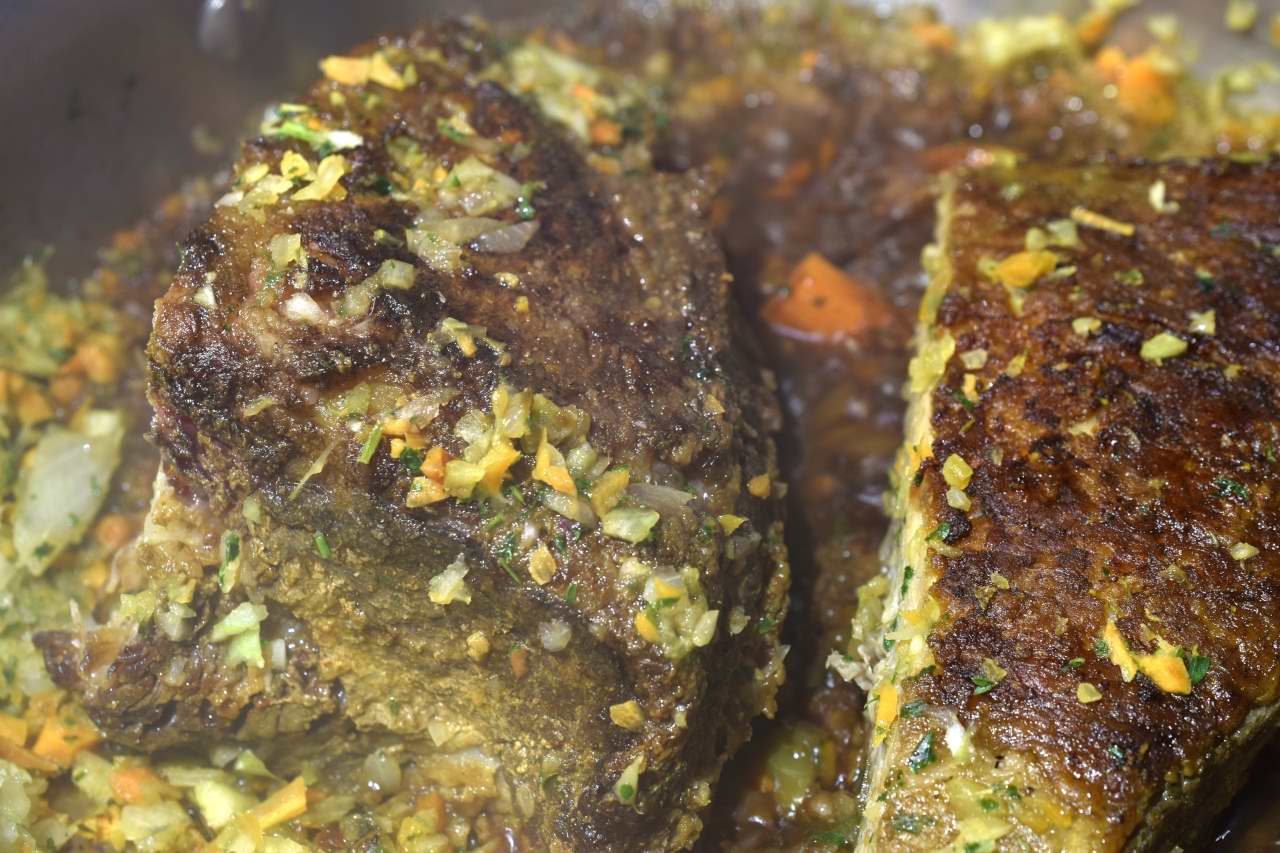
Add the wine and stir once. Allow the wine to reduce completely–wine adds flavor to sauces–not volume.
Add the clarified sous jus, the tomato sauce, the fennel seeds, bay leaves and the oregano. Bring to a simmer, reduce heat to low and cover. While the Stracotto simmers, remove the parsley from the bag and lightly fluff it out on a flat surface. Let it rest there for half an hour before staging into a more convenient container.
Continue simmering the brisket for one hour or until it is soft enough for the next step. Remove the cover and turn the burner all the way down. Use two forks to pull/tear the meat apart, but do not shred it into taco meat. We are trying to create the impression that the meat fell apart on its own but in a more orderly fashion. Add the capers, the peas, half the parsley and the cold butter, stir once, cover and turn off the burner. Do not boil again.
Turn the oven on to the “warming” function, up to 225 F/107 C but no higher. Put the plates in the oven. If you feel that the oven is too hot, leave the door slightly open.
Service:
Professional cooks know that the difference between hot and cold food is more about the plate than the food itself. Cold food on a hot plate will not heat, but hot food on a cold plate will definitely turn cold. When the cook sees the server arrange the plates on a tray and then walk away to enter something into the computer or chat with another server, the cook finally understands why the chef insisted that the plates be heated.
The alternative is to chastise the server, which almost always backfires. While the two of you argue, the food gets even colder. Diners in restaurants blame the chef when their food arrives cold, but chefs do not know how to cook food to a cold state. Food to be served hot is always hot when it hits the plate. What happens to it after that depends on the server. This principle applies at home as well.
&%$#@*&#$&?!!!!!
No sooner will you have created numerous beautiful presentations to impress your guests than the phone will ring, the dog will start barking or some other crisis will present itself. If your plates are cold you may experience severe anxiety and even lose your temper, causing your friends and family to question your sanity. Imbibing alcohol or whatever while you cook can amplify this phenomenon. If the plates are really hot, it’s no big deal.
Before I go down the rabbit hole
Bring 2 quarts/2 liters of water to a boil in the sauce pot. Cook the rigatoni (or pasta of your choice) al dente as per the directions on the package. I like to make my own, but that is another story. When the pasta is done, drain in the colander but DO NOT WASH. Add the pasta and the grated cheese to the sauce. Stir lightly until coated.
Put a dry towel or trivet on the work surface. Put the skillet of pasta on the dry towel. You can transfer it to a large bowl if you prefer, but that just creates one more dish to wash. Use dry towels to arrange the heated plates on the work surface. This is not a good time to burn your bare thumb on a plate.
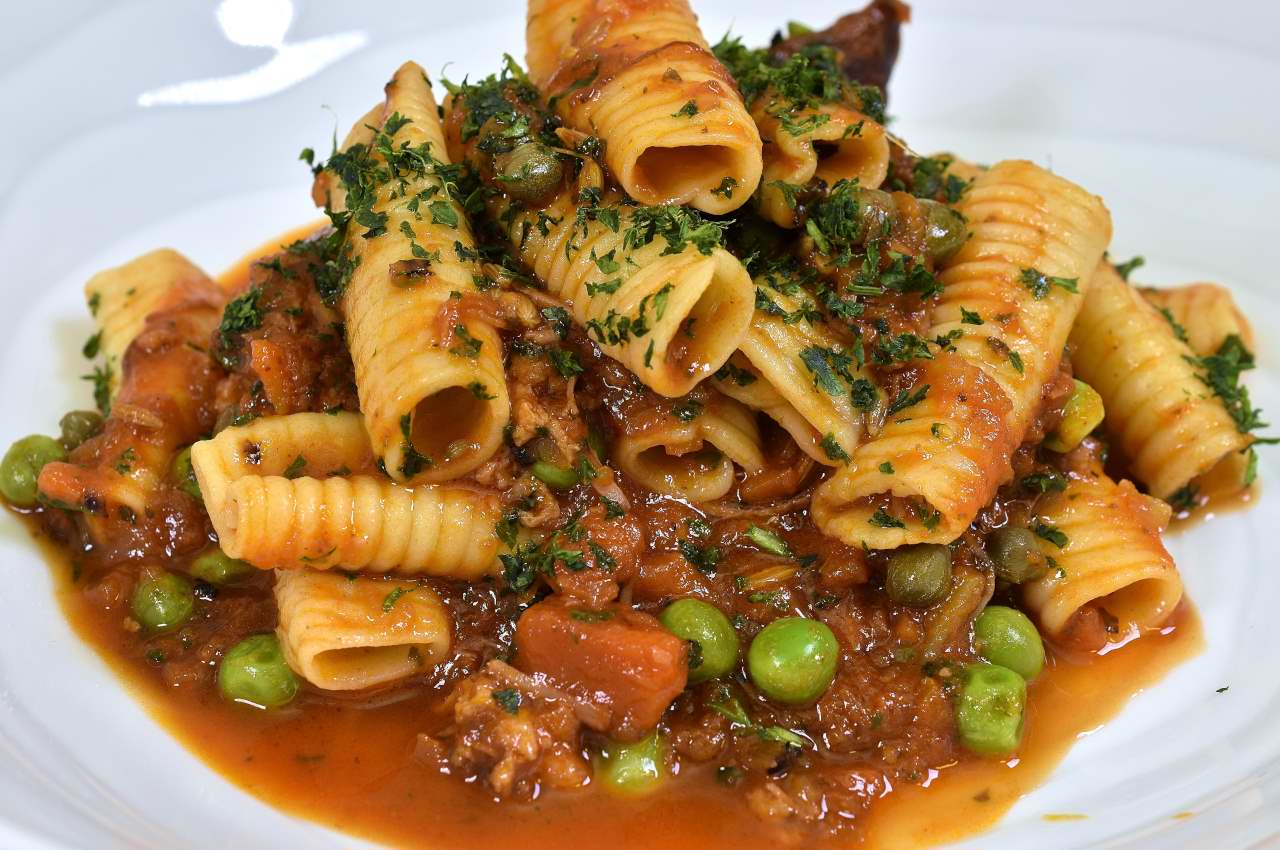
Divide the pasta evenly among the plates, but leave some of the sauce in the pan so it doesn’t end up on the bottom hiding under the pasta. Garnish generously with the chopped parsley. Many people assume that everything Italian with red in it gets grated cheese on top, but this is not to be taken for granted. Tossing the cheese in the sauce does make it cling to the pasta.

The great thing about rigatoni, penne, gnocchi, garganelli, etc. is that they are much easier to present than spaghetti, linguine, and fettuccine. They usually coil the long ones downtown, so I always feel obligated to oblige.

I’m not going to say “MANGIA!” because that’s like sitting down at the table with your guests and saying “EAT!” Who does that?
Norm King
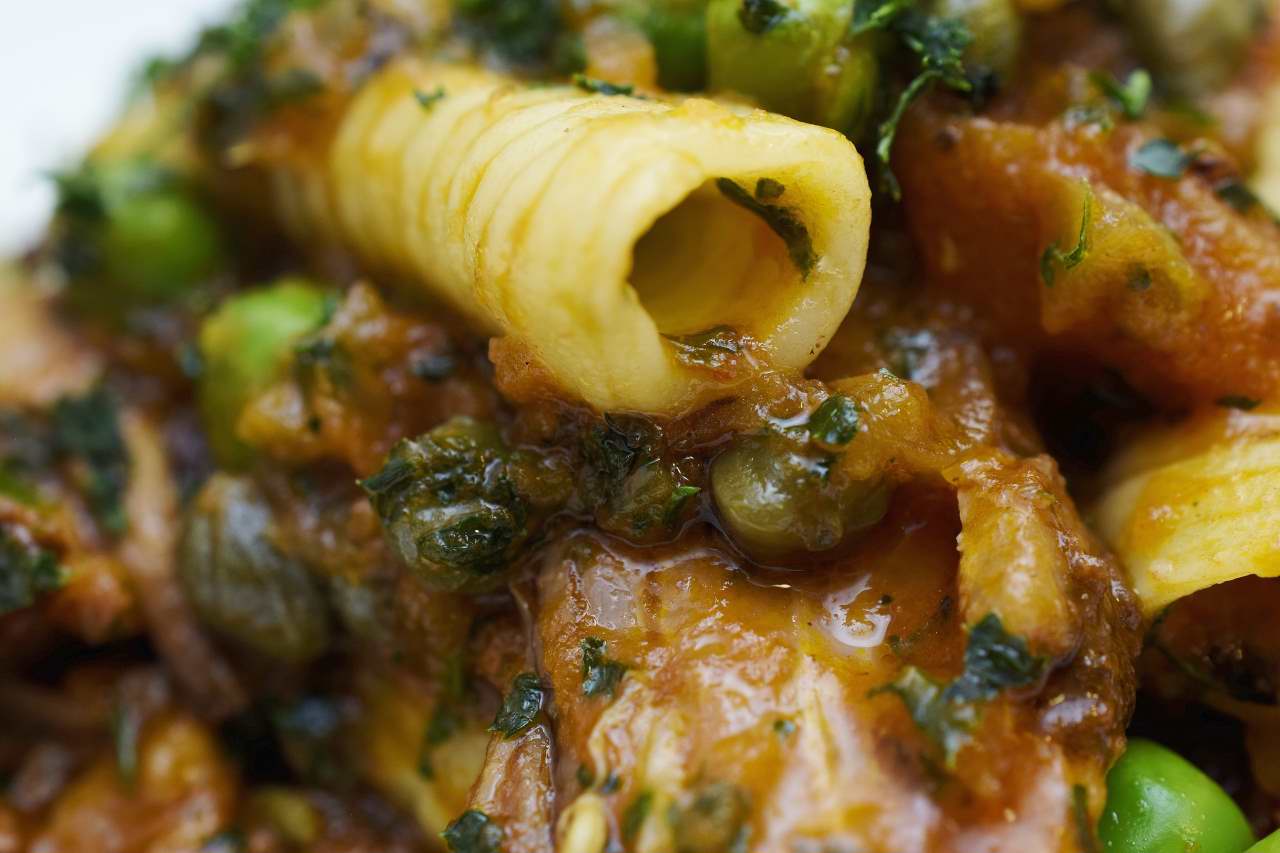


Hello, all the time i used to check web site posts here early in the dawn, since
i like to learn more and more.
Also visit my page: vpn special code
I don’t know if it’s just me or if perhaps everyone else encountering issues with your blog.
It looks like some of the text within your content are running off the screen.
Can somebody else please provide feedback and let me know if this is happening
to them as well? This might be a issue with my browser
because I’ve had this happen before. Many thanks
Feel free to visit my website :: vpn coupon 2024
I all the time emailed this weblog post page facebook vs eharmony to find love online all
my contacts, for the reason that if like to read it after that my
contacts will too.